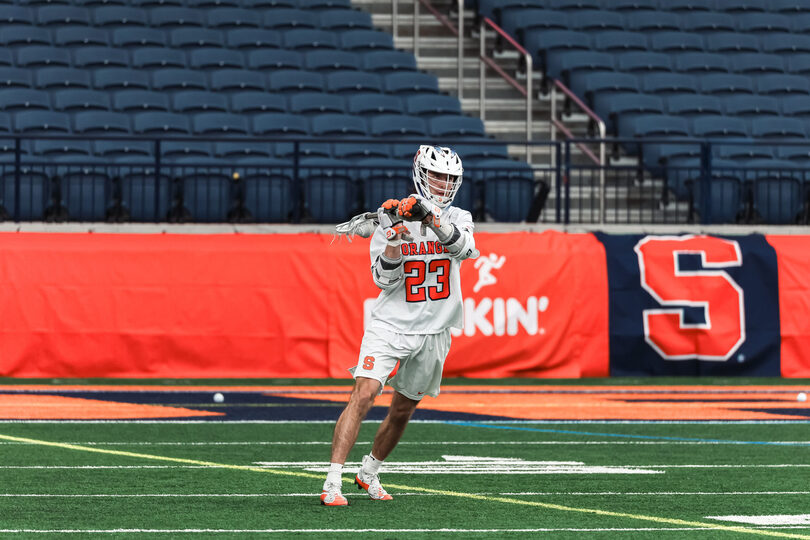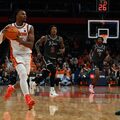Finn Thomson’s return from mid-season injury fuels SU’s national title chase

Since returning from a mid-season injury he suffered versus Utah, Finn Thomson has helped Syracuse’s offense average 13.75 goals in its four postseason games. Joe Zhao | Senior Staff Photographer
Get the latest Syracuse news delivered right to your inbox. Subscribe to our sports newsletter here.
Finn Thomson isn’t an avid reader. That doesn’t mean he’s not open to books. If a family member or friend recommends one, he doesn’t hesitate to read it if he feels it’ll help him.
After breaking his left arm in March, Thomson’s friend Lucas Dudemaine, a midfielder at Georgetown, suggested reading “The Obstacle Is the Way” by Ryan Holiday. Dudemaine read the nonfiction book when he was injured in the fall and thought it’d help Thomson.
At the time, Thomson needed guidance. He had scored 13 goals in five games after moving from midfield to attack, including a career-high five tallies against Harvard on Feb. 22. Thomson was playing the best lacrosse of his career, but his injury derailed everything.
Initially frustrated at the setback, Thomson said reading the book helped him stay even-keeled. One of its key themes is to “flip obstacles into opportunity,” which taught Thomson to treat his injury as a positive.
“If you look at it through a mental perspective of, ‘I’m just getting better every day’ and ‘This injury isn’t going to tear me down, it’s going to bring me back up,’” Thomson said. “That’s definitely one of the big themes that I got from it.”

Finn Thomson runs downfield in his first game back from injury at Duke on April 19. After breaking his arm and missing six games, Thomson has propelled Syracuse to its first Final Four since 2013. Leonardo Eriman | Photo Editor
Thomson was sidelined for seven weeks before returning in April, allowing him to reacclimate before Syracuse’s postseason run. Since returning, Thomson’s scored seven goals in six games while also making his presence known through off-ball movement and flashy finishes on the crease, helping Syracuse clinch its first Final Four appearance since 2013. Now the Orange face No. 2 seed Maryland on Saturday in Foxborough, Massachusetts with a National Championship game berth on the line.
“Coming off a fractured arm, it’s tough, but I think he’s done a great job to get back at it,” SU head coach Gary Gait said. “He’s 100 percent right now, so we’re excited to have him and be full strength with our attack lineup.”
Thomson broke his arm on March 1 against Utah. In the second quarter, he said a defender slashed him when he picked up a ground ball. A couple minutes later, he assisted an Owen Hiltz score and was checked out by Syracuse trainer Bradley Sammut on the sideline. Thomson returned after Sammut said nothing was broken and scored two minutes later. But soon after, he took another whack on the arm. Thomson remained sidelined for the second half.
After further evaluation, Thomson was diagnosed with a broken arm and needed surgery. Following SU’s 13-10 win over Johns Hopkins on March 9, Gait said postgame that Thomson would be “out for a while.”
His absence was a tough blow for Syracuse. Thomson had scored nine goals in his previous three games before getting hurt. He adjusted well to Syracuse’s attack after accumulating 71 points in his first two seasons as a midfielder.
The position change was a long time coming. Thomson was the No. 5 recruit in the 2022 class, according to Inside Lacrosse, and a natural attack throughout high school. However, Gait deployed graduate students Alex Simmons and Christian Mulé in 2023 and 2024, respectively, as the third attacks with Joey Spallina and Hiltz.
This past fall, Thomson made the vacant attack spot his. The move wasn’t planned, with Thomson explaining that “your spots are never set in stone” at Syracuse.
“You have to be good at the things that take no talent,” Thomson said. “Obviously we have a lot of talent on this team, and we know that the little things are going to bring us to the level that we want to.”
SU offensive coordinator Pat March uses Thomson in many ways. March described the junior as an “extremely smart player” who “doesn’t need to have the ball to be an offensive threat.” Thomson can seamlessly work pick-and-rolls with Spallina — the main facilitator in the Orange’s offense — at X or cut off the ball for one of Hiltz’s wild cross-field skip passes.
Typically, Thomson lives around the crease. He can operate in the open, but his box lacrosse background makes him best-suited for tight spaces. Whether Thomson draws a long pole or short stick matchup, he often scores via catch-and-shoot.
It means his touches are usually limited, but he makes the most of them. Thomson is a walking highlight reel with a jaw-dropping goal catalog.
No-look between the legs against Jacksonville? No problem. Behind-the-back with pinpoint accuracy versus Duke in the ACC Championship Game? Of course. Underhand shovel finish in the NCAA Quarterfinals against Princeton? Easy money.
“He’s able to, with even a bad pass, make a play whether the ball is thrown high, whether it’s thrown low,” March said. “The stick becomes almost an extension of his body.”
Thomson’s finishes leave his peers in awe. He’s often asked if he ever scores normally. Thomson responds by saying that he tries to, but he’s just doing what comes naturally. There’s not an exact science to the shots.
“The great thing about playing offense at Syracuse is when you’re thinking you’re not playing well, when you’re not thinking you’re having fun, and that’s a big pillar of our offense,” Thomson said.
Thomson attributes his skillset to his three older brothers Tanner, Keaton and Hudson. The trio — all of whom played college lacrosse at Marquette — helped mold him into the player he is now. Keaton, who played in the National Lacrosse League, said Thomson got the most coaching out of the three as the youngest.
It was rare not to find at least two brothers in the backyard, whipping full-speed passes from 10, 15 and 20 yards before shooting on net. The group’s sticks were glued to their hands, even on vacations to the beach. Tanner said they practiced basic overhand passes, but creativity was preached — behind-the-back tosses, between-the-legs scores and everything in between.
The same creativity helped enhance Thomson’s finishing ability. Keaton used a drill he learned from Tehoka Nanticoke, his former teammate with the NLL’s Buffalo Bandits. Keaton had his brother stand in front of their net and would whip hard passes from X that were intentionally off the mark. Finn had to react fast enough to catch the bad pass and get a shot off.
“Sure, Finn took a couple in the face in the process, (but it) definitely paid off in the end,” Keaton said.
While Keaton doesn’t credit the specific drill for Finn’s soft hands, Tanner pointed to how much lacrosse his brother played.
“Finn never takes more than a week off from touching a stick for the whole year. He’s never really lost it and just kept getting better.” Tanner said.
That’s why Thomson’s injury was so detrimental. From the time his rehab started, he was desperate to get back on the field. Thomson helplessly stared at the sticks in his room everyday, anxiously waiting until he could grip one again. He knew his recovery process would speed up once he started practicing, but he remained patient.
If you look at it through a mental perspective of, ‘I’m just getting better every day’ and ‘This injury isn’t going to tear me down, it’s going to bring me back up.’ That's definitely one of the big themes that I got from it.Finn Thomson, SU men’s lacrosse attack
The Orange had adequate replacements in Trey Deere and Payton Anderson, who each started games at attack during Thomson’s six-game absence. Deere recorded four goals against Colgate on March 22, but he was benched for Anderson once ACC play started. The freshman displayed his potential with five points across two wins over Virginia and Notre Dame on March 29 and April 5.
Despite Anderson’s success, Thomson wanted to return. After a 17-12 loss against Cornell on April 12, Thomson said Syracuse was banged up. He wasn’t 100% yet either, but he wanted to boost the team morale, so he decided to play against Duke.
“Once I got a stick back, I was like, ‘Alright, I can do this, I’m good boys.’” Thomson said. “I wanted to be back out there with them, so it was a no-brainer, just coming back to it and trying to get in the swing of things as fast as possible.”
Thomson’s comeback didn’t go as planned. He came off the bench and didn’t record a point. Syracuse tied its worst offensive performance of the season, falling 11-7 to the Blue Devils. The following week against North Carolina, the Orange faltered again, with Thomson fully recovered, losing 14-12. Thomson scored twice, but outside of a quick four-goal fourth-quarter flurry, the offense was quiet.
Syracuse finished the season on a three-game losing streak and put its NCAA Tournament hopes in jeopardy. Since, the Orange have turned their campaign around with wins over Notre Dame, Duke, Harvard and Princeton, while the offense averages 13.75 goals per game. Thomson said SU’s sustained success boils down to everyone being hyper-focused on their roles.
For him, that means exploiting small openings within the defense, setting efficient picks and making the right passes. They’re plays that go unnoticed on the stat sheet but have just as big of an effect.
Thomson might not get the recognition of Spallina or Hiltz due to their high-volume usage, but his role is just as important. He’s an important cog within SU’s offense willing to do the dirty work needed to bring Syracuse its first National Championship since 2009.






